Jungle Book’s plot structure interweaves 4 mythological tales
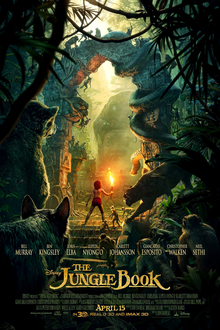
-
Est. vs Actual domestic box office revenue
$315-385MM/ $364MM - Four mythological tales reveal the invisible plot structure
Jungle Book movie directed by Jon Favreau is based on the book by Rudyard Kipling. The story crafted by Justin Marks follows Mowgli the man-cub being hunted Shere Khan the tiger. The movie explores basic human desires of Preservation, Tranquillity, Family & Accumulation. Mythosis uses 4 mythological tales to extract the plot structure of the movie.
1. Mythological tales reveal the invisible plot structure of any story
1A. 94% of the events are borrowed from 4 mythological tales
Shere Khan's quest is driven by the desire to survive a threat and mirrors the tale of Kans from Hindu mythology. Both Kans & Shere Khan fail to prevent their nemesis from escaping.
Mowgli's quest is driven by the desire to be in secure surroundings and mirrors the tale of Odysseus from Greek mythology. Both Odysseus & Mowgli survive multiple obstacles before returning home.
Bagheera’s quest is driven by the desire to protect loved ones and mirrors the tale of Demeter from Greek mythology. Both Demeter & Bagheera recover their lost loved ones.
Baloo’s quest is driven by the desire to accumulate & own and mirrors the tale of Valmiki from Hindu mythology. Both Valmiki & Baloo give up their selfish endeavours to help others.
Raksha, Kaa & King Louie have underdeveloped quests. They mirror supporting characters in the tale of Odysseus and are subsumed in the quest of Mowgli.
Detailed mirroring of each character to their respective mythological tales is in section “Unlocking the Ideal Plot Structure”
Mowgli's quest is driven by the desire to be in secure surroundings and mirrors the tale of Odysseus from Greek mythology. Both Odysseus & Mowgli survive multiple obstacles before returning home.
Bagheera’s quest is driven by the desire to protect loved ones and mirrors the tale of Demeter from Greek mythology. Both Demeter & Bagheera recover their lost loved ones.
Baloo’s quest is driven by the desire to accumulate & own and mirrors the tale of Valmiki from Hindu mythology. Both Valmiki & Baloo give up their selfish endeavours to help others.
Raksha, Kaa & King Louie have underdeveloped quests. They mirror supporting characters in the tale of Odysseus and are subsumed in the quest of Mowgli.
Detailed mirroring of each character to their respective mythological tales is in section “Unlocking the Ideal Plot Structure”
1B. 32 mythological tales are the source of all stories, even the untold ones
Human beings are driven by 16 fundamental desires. Every desire, whether encountering fulfilment or unfulfillment, gives rise to two distinct quests. Thus, a spectrum of 32 unique quests mirrors every human desire.
We have discovered mythological tales from across civilizations that uniquely portray each one of these 32 human quests. While each mythological tale stands as a distinct quest, the true magic unfolds when these tales are combined. This synergy is evident in the epics of Odyssey and Ramayan, where various universal quests seamlessly intertwine.
Combining any five tales from the 32, generates a staggering 24 million unique story plots. Take it a step further, by combining six tales the possibilities explode to an astounding 600 million!
The unique plot structure of Jungle Book is # 657,101. It emerges from interweaving the tales of Kans, Demeter, Odysseus & Valmiki.
We have discovered mythological tales from across civilizations that uniquely portray each one of these 32 human quests. While each mythological tale stands as a distinct quest, the true magic unfolds when these tales are combined. This synergy is evident in the epics of Odyssey and Ramayan, where various universal quests seamlessly intertwine.
Combining any five tales from the 32, generates a staggering 24 million unique story plots. Take it a step further, by combining six tales the possibilities explode to an astounding 600 million!
The unique plot structure of Jungle Book is # 657,101. It emerges from interweaving the tales of Kans, Demeter, Odysseus & Valmiki.
2. Plot structure potential of Jungle Book: $315-385MM
2A. Plot structure evaluation
An analysis of Blockbuster, Hit & Flop plots has led to the discovery of Mythosis Code. The Code reveals the story principles shared by all Blockbusters. We use the Code to estimate a story’s potential.
- All Blockbusters have at least 3 universal quests. Jungle Book uses 4 universal quests of Preservation, Tranquillity, Family and Accumulation.
- In Blockbusters, each universal quest is mirrored by ONLY ONE character. Shere Khan mirrors the quest of Preservation. Mowgli mirrors the quest of Tranquillity. Bagheera mirrors the quest of Family whereas the Baloo mirrors the quest of Accumulation.
- Every Blockbuster character borrows at least 35% of the universal quest. Shere Khan borrows 36% of events from the quest for Preservation. Mowgli borrows 39% of events from the quest of Tranquillity. Bagheera borrows 16% from the universal quest of Family. Baloo borrow 19% from the universal quest of Accumulation.
- Blockbusters interweave different quests to create a tight plot structure. Interweaving occurs when events of 2 quests occur simultaneously in the story. Blockbusters have a quest interweaving threshold of 0.5. The quest interweaving score of Jungle Book is 0.50 and is at par. An example of interweaving the quests of Mowgli & Shere Khan:

2B. Estimating revenue potential of plot structure
Though the plot structure of Spotlight borrows events from 4 mythological tales, only 2 of the tales have been used adequately. Bagheera & Baloo's quests are shallow.
We have created an algorithm by assigning weights to the principles of The Mythosis Code. The algorithm calculates the potency of a story’s plot structure and estimates its corresponding audience appeal. Blockbuster plot structures have a score of at least 0.64 and appeal to 20% of the audiences.
Jungle Book has a script potential score is 0.39 and the movie will appeal to 11.25 – 13.75% of the population. Our estimate of the movie’s revenues from its audience appeal is $315 – 385MM in the domestic market. The movie’s actual revenue was $364MM.
We have created an algorithm by assigning weights to the principles of The Mythosis Code. The algorithm calculates the potency of a story’s plot structure and estimates its corresponding audience appeal. Blockbuster plot structures have a score of at least 0.64 and appeal to 20% of the audiences.
Jungle Book has a script potential score is 0.39 and the movie will appeal to 11.25 – 13.75% of the population. Our estimate of the movie’s revenues from its audience appeal is $315 – 385MM in the domestic market. The movie’s actual revenue was $364MM.
3. The ideal plot structure of Jungle Book
We have identified 32 universal quests that represent every human desire. These quests are the superset of thousands of stories across cultures that reflect our collective subconscious. Each quest has a structured sequence of events divided into 5 major arcs.
We map a character’s quest to the relevant mythological tale (universal quest) which reveals the gaps in their quest, if any. The ideal Plot Structure is constructed by plugging these gaps with the missing events from the tale. These events strengthen both the journey of characters as well as the weaving of quests without altering the story.
We map a character’s quest to the relevant mythological tale (universal quest) which reveals the gaps in their quest, if any. The ideal Plot Structure is constructed by plugging these gaps with the missing events from the tale. These events strengthen both the journey of characters as well as the weaving of quests without altering the story.
3A. Quest of characters and their mythological counterparts
Quest 1: Shere Khan mirrors the universal quest for Preservation
Shere Khan’s desire for Preservation stems from the need to survive a threat. The tale of Kans from Hindu mythology is the universal quest for Preservation.
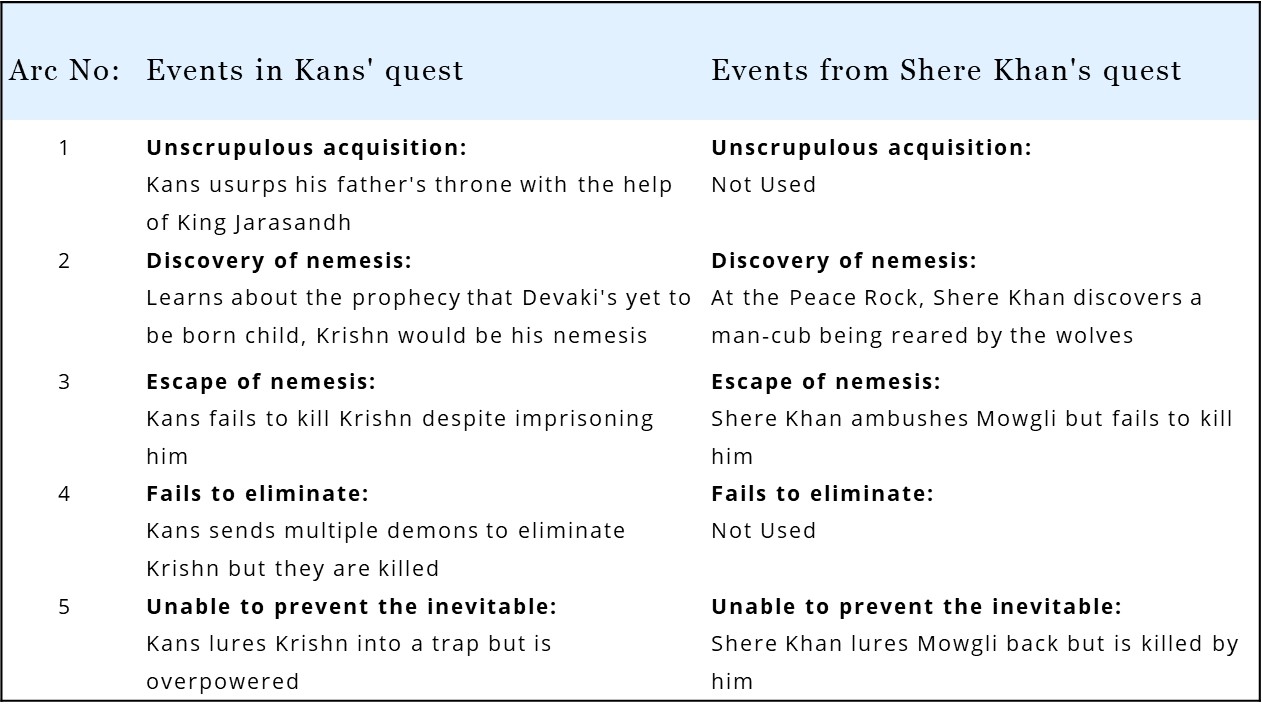
Quest 2: Mowgli mirrors the universal quest for Tranquillity
Mowgli’s desire for Tranquillity stems from the need to be in secure surroundings. The tale of Odysseus from Greek mythology is the universal quest for Tranquillity.
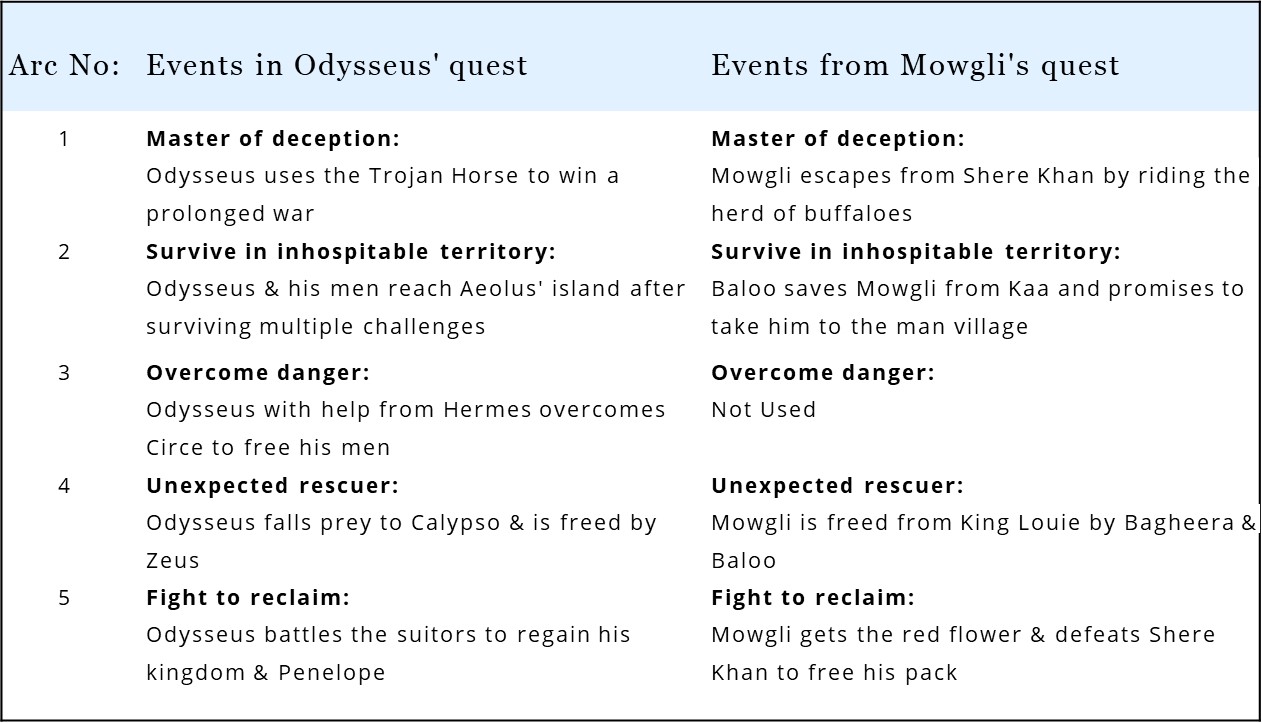
Quest 3: Bagheera mirrors the universal quest for Family
Bagheera’s desire for Family stems from the need to protect loved ones. The tale of Demeter from Greek mythology is the universal quest for Family.
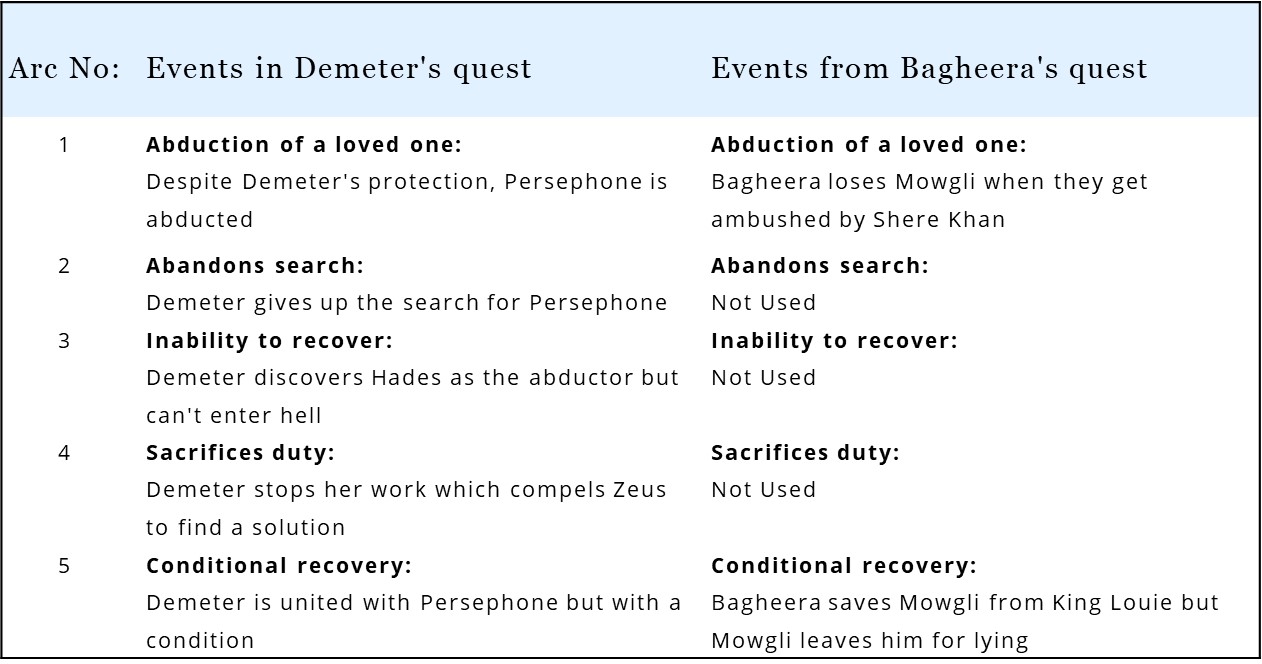
Quest 4: Baloo mirrors the universal quest for Accumulation
Baloo’s desire for Accumulation stems from the need to collect & own. The tale of Valmiki from Hindu mythology has a robust expression in Dicken’s character of Scrooge which is the universal quest for Accumulation.
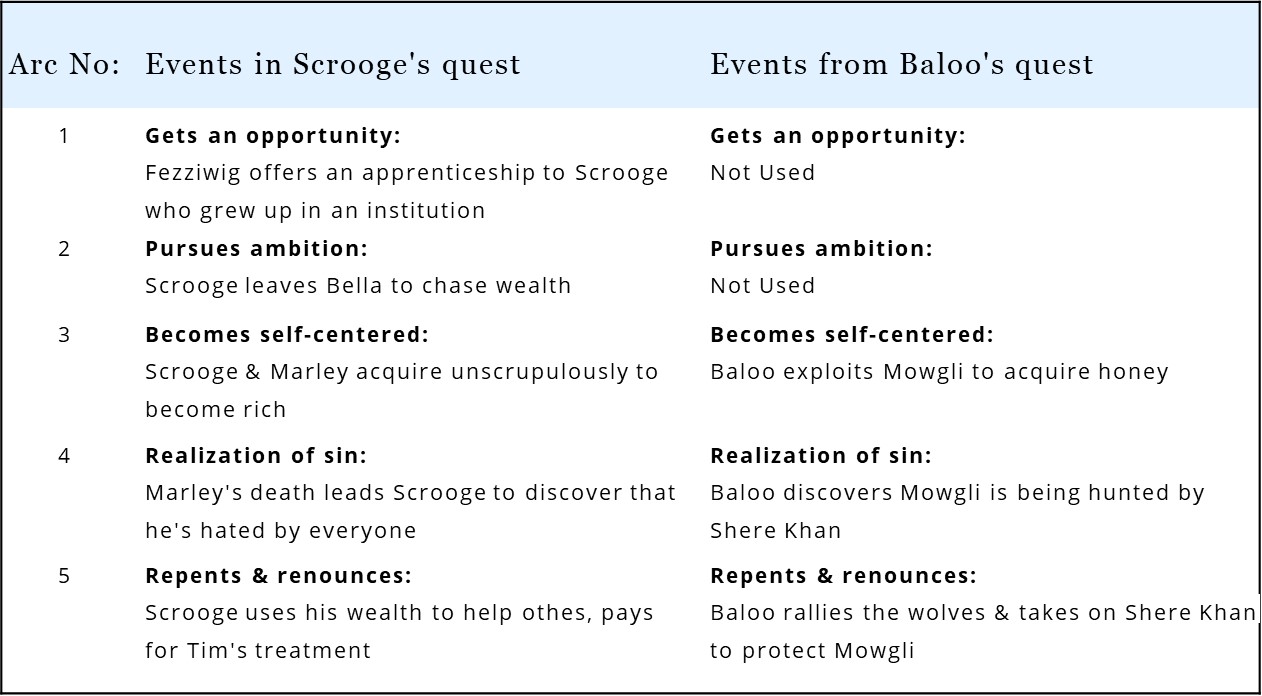
- Tags: 2016, Accumulation, Blockbuster movies, Demeter, Family, Jon Favreau, Justin Marks, Kans, Mythology, Odysseus, Plot Structure, Prediction, Preservation, storytelling, Tranquillity, Valmiki, Walt Disney Studios Motion Pictures
